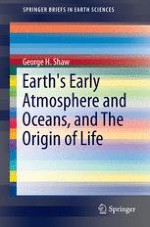2016 | OriginalPaper | Buchkapitel
4. Degassing Processes and Chemistry
verfasst von : George H. Shaw
Erschienen in: Earth's Early Atmosphere and Oceans, and The Origin of Life
Aktivieren Sie unsere intelligente Suche, um passende Fachinhalte oder Patente zu finden.
Wählen Sie Textabschnitte aus um mit Künstlicher Intelligenz passenden Patente zu finden. powered by
Markieren Sie Textabschnitte, um KI-gestützt weitere passende Inhalte zu finden. powered by
